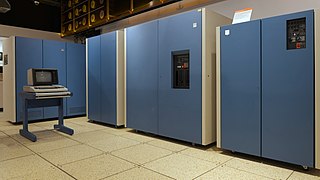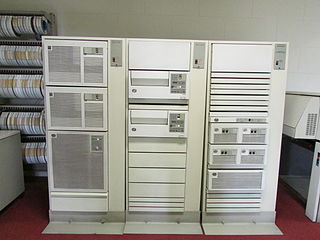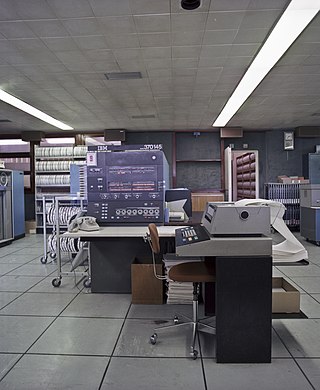
The IBM System/370 (S/370) is a range of IBM mainframe computers announced as the successors to the System/360 family on June 30, 1970. The series mostly maintains backward compatibility with the S/360, allowing an easy migration path for customers; this, plus improved performance, were the dominant themes of the product announcement.

The IBM 1440 computer was announced by IBM October 11, 1962. This member of the IBM 1400 series was described many years later as "essentially a lower-cost version of the 1401", and programs for the 1440 could easily be adapted to run on the IBM 1401.

The IBM 4300 series are mid-range systems compatible with System/370 that were sold from 1979 through 1992. They featured modest electrical and cooling requirements, and thus did not require a data center environment. They had a disruptive effect on the market, allowing customers to provide internal IBM computing services at a cost point lower than commercial time-sharing services. All 4300 processors used a 3278-2A, 3279-C or 3205 display console rather than a 3210 or 3215 keyboard/printer console.
Plug compatible refers to "hardware that is designed to perform exactly like another vendor's product." The term PCM was originally applied to manufacturers who made replacements for IBM peripherals. Later this term was used to refer to IBM-compatible computers.
The IBM 2780 and the IBM 3780 are devices developed by IBM for performing remote job entry (RJE) and other batch functions over telephone lines; they communicate with the mainframe via Binary Synchronous Communications and replaced older terminals using synchronous transmit-receive (STR). In addition, IBM has developed workstation programs for the 1130, 360/20, 2922, System/360 other than 360/20, System/370 and System/3.

The Wang 2200 was an all-in-one minicomputer released by Wang Laboratories in May 1973. Unlike some other desktop computers, such as the HP 9830, it had a cathode-ray tube (CRT) in a cabinet that also included an integrated computer-controlled cassette tape storage unit and keyboard. It was microcoded to run BASIC on startup, making it similar to home computers of a few years later. About 65,000 systems were shipped in its lifetime and it found wide use in small and medium-size businesses worldwide.

Operating System/Virtual Storage 1, or OS/VS1, is a discontinued IBM mainframe computer operating system designed to be run on IBM System/370 hardware. It was the successor to the Multiprogramming with a Fixed number of Tasks (MFT) option of System/360's operating system OS/360. OS/VS1, in comparison to its predecessor, supported virtual memory. OS/VS1 was generally available during the 1970s and 1980s, and it is no longer supported by IBM.

The IBM 9370 systems are "baby mainframe" midrange computers, released 1986 at the very low end of, and compatible with System/370. The media of the day, referring to the VAX systems manufactured by Digital Equipment Corporation (DEC), carried IBM's alleged "VAX Killer" phrase, albeit often skeptically.
The IBM 2922 Programmable Terminal is a Remote Job Entry (RJE) terminal introduced by IBM in 1972. The 2922 communicates using Binary Synchronous Communications (Bisync).

The IBM System/360 Model 50 is a member of the IBM System/360 family of computers. The Model 50 was announced in April 1964 with the other initial models of the family, and first shipped in August 1965 to the Bank of America.

The IBM System/360 Model 25 is a low-end member of the IBM System/360 family. It was announced on January 3, 1968, 3 years before the IBM System/360 Model 22, as a "bridge between its old and new computing systems".

The IBM System/370 Model 155 were jointly announced Jun 30, 1970 as "designed for ... the Seventies." That same day IBM announced the 370/195. They were the first three models of the IBM System/370 line of computers.

The IBM System/370 Model 165 were jointly announced June 30, 1970 as "designed for ... the Seventies." That same day IBM announced the 370/195. They were the first three models of the IBM System/370 line of computers.

The IBM System/370 Model 145 was announced September 23, 1970, three months after the 155 and 165 models. It was the fourth member of the IBM System/370 line of computers, and was the first IBM computer to use semiconductor memory for its main memory instead of magnetic core memory. It was described as being five times faster than the IBM System/360 Model 40. First shipments were scheduled for late summer of 1971.

The IBM System/370 Model 135 was announced March 8, 1971, the only 370 introduced that year. The 135 was IBM's fifth System 370, and it was withdrawn October 16, 1979.

The IBM 303X is a discontinued line of mainframe computers, the first model of which, the IBM 3033 Processor, nicknamed "The Big One", was introduced March 25, 1977.

The IBM System/370 Model 168 and Model 158 were both announced on August 2, 1972. Prior 370 systems had not "offered virtual storage capability, which was to be a hallmark of the 370 line," and some said that the 168 and 158 were the first "real 370" products. By contrast, "in 1972, the System/370 Advanced Function was released and had new Address Relocation Hardware and now supported four new operating systems ."

The IBM System/390 is a discontinued mainframe product family implementing ESA/390, the fifth generation of the System/360 instruction set architecture. The first computers to use the ESA/390 were the Enterprise System/9000 (ES/9000) family, which were introduced in 1990. These were followed by the 9672, Multiprise, and Integrated Server families of System/390 in 1994–1999, using CMOS microprocessors. The ESA/390 succeeded ESA/370, used in the Enhanced 3090 and 4381 "E" models, and the System/370 architecture last used in the IBM 9370 low-end mainframe. ESA/390 was succeeded by the 64-bit z/Architecture in 2000.

The IBM System/370 Model 115 was announced March 13, 1973, at that time the low-end model of the System/370 line. It was promoted as "an ideal System/370 entry system for users of IBM's System/3, 1130 computing system and System/360 Models 20, 22 and 25."

IBM developed, manufactured and sold hammer-based impact printers that used either type bars, a chain, a train, or a band to create printed output from 1959 till 1999, replacing the older print drum technology,. Over the course of this time they produced a wide variety of these line printers. This article will detail the most significant ones. Note that while IBM initially described band printers as belt printers, they are effectively the same thing.















